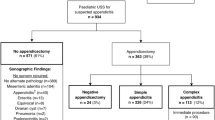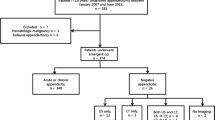Abstract
Background
Little is known about ‘normal’ local sonographic changes occurring in the postoperative period after an uneventful appendectomy.
Objective
To analyse the local changes on US examination occurring after uneventful open (OA) or laparoscopic (LA) appendectomy in children with normal histology and with nonperforated acute appendicitis.
Materials and methods
US was prospectively performed in 82 children (54 boys and 28 girls) aged 1–16 years (mean 11.6±3.2 years), 3 days following LA (n=51, 62%) or OA (n=31, 38%) for nonperforated appendicitis. Multivariate analysis was performed using stepwise logistic regression, with the following starting variables: surgical technique, gender, pathological finding, appendix location, and histology.
Results
Of the 82 patients, 35 (42.7%) had postoperative pathological US findings such as peritoneal fluid, oedematous mesenteric fat and thickening of the bowel wall. While the overall incidence of pathological US findings between OA and LA groups was not significantly different, multivariate logistic regression analysis showed that OA is associated with a reduction by a factor of 0.35 in the odds ratio of postoperative pathological US findings (P=0.007).
Conclusion
Pathological US findings are common in children after appendectomy, particularly after LA. Awareness of these pathological findings might prevent unnecessary postoperative treatment.



Similar content being viewed by others
References
Wong ML, Casey SO, Leonidas JC et al (1994) Sonographic diagnosis of acute appendicitis in children. J Pediatr Surg 29:1356–1360
Vasavada P (2004) Ultrasound evaluation of acute abdominal emergencies in infants and children. Radiol Clin North Am 42:445–456
Sivit CJ, Applegate KE (2003) Imaging of acute appendicitis in children. Semin Ultrasound CT MR 24:74–82
Peletti AB, Baldisserotto M (2006) Optimizing US examination to detect the normal and abnormal appendix in children. Pediatr Radiol 36:1171–1176
Baker DE, Silver TM, Coran AG et al (1986) Postappendectomy fluid collections in children: incidence, nature, and evolution evaluated using US. Radiology 161:341–344
Gorenstein A, Gewurtz G, Serour F et al (1994) Postappendectomy intra-abdominal abscess: a therapeutic approach. Arch Dis Child 70:400–402
Aveline B, Guimaraes R, Bely N et al (1993) lntraabdominal serous fluid collections after appendectomy: a normal sonographic finding. AJR 161:71–73
Neff CC, Simeone JF, Ferrucci JT Jr (1983) The occurrence of fluid collections following routine abdominal surgical procedures: sonographic survey in asymptomatic postoperative patients. Radiology 146:463–466
Ignacio RC, Burke R, Spencer D et al (2004) Laparoscopic versus open appendectomy: what is the real difference? Results of a prospective randomized double-blinded trial. Surg Endosc 18:334–337
Oka T, Kurkchubasche AG, Bussey JG (2004) Open and laparoscopic appendectomy are equally safe and acceptable in children. Surg Endosc 18:242–245
Sauerland S, Lefering R, Neugebauer EAM (2004) Laparoscopic versus open surgery for suspected appendicitis. Cochrane Database of Systematic Reviews, Issue 4. Art. no. CD001546. doi:10.1002/14651858.CD001546.pub2
Neuhaus SJ, Watson DI (2004) Pneumoperitoneum and peritoneal surface changes. A review. Surg Endosc 18:1316–1322
Serour F, Witzling M, Gorenstein A (2005) Is laparoscopic appendectomy in children associated with an uncommon postoperative complication? Surg Endosc 19:919–922
Reid RI, Dobbs BR, Frizelle FA (1999) Risk factors for post-appendicectomy intra-abdominal abscess. Aust N Z J Surg 69:373–374
Ein S, Wales P, Langer JC et al (2008) Is there a role for routine abdominal imaging in predicting postoperative intraabdominal abscess formation after appendectomy for pediatric ruptured appendix? Pediatr Surg Int 24:307–309
Paik PS, Towson JA, Anthone GJ et al (1997) Intra-abdominal abscesses following laparoscopic and open appendectomies. J Gastrointest Surg 1:188–193
Horwitz JR, Custer MD, May BH et al (1997) Should laparoscopic appendectomy be avoided for complicated appendicitis in children? J Pediatr Surg 32:1601–1603
Krisher SL, Browne A, Dibbins A et al (2001) Intra-abdominal abscess after laparoscopic appendectomy for perforated appendicitis. Arch Surg 136:438–441
Kouwenhoven EA, Repelaer van Driel OJ, van Erp WF (2005) Fear for the intraabdominal abscess after laparoscopic appendectomy: not realistic. Surg Endosc 19:923–926
McKinlay R, Neeleman S, Klein R et al (2003) Intraabdominal abscess following open and laparoscopic appendectomy in the pediatric population. Surg Endosc 17:730–733
Moraitis D, Kini SU, Annamaneni RK (2004) Laparoscopy in complicated pediatric appendicitis. JSLS 8:310–313
Ikeda H, Ishimaru Y, Takayasu H et al (2004) Laparoscopic versus open appendectomy in children with uncomplicated and complicated appendicitis. J Pediatr Surg 39:1680–1685
Volz J, Koster S, Spacek Z et al (1999) Characteristic alterations of the peritoneum after carbon dioxide pneumoperitoneum. Surg Endosc 13:611–614
Bloechle C, Kluth D, Holstein AF et al (1999) A pneumoperitoneum perpetuates severe damage to the ultrastructural integrity of parietal peritoneum in gastric perforation-induced peritonitis in rats. Surg Endosc 13:683–688
Rosário MT, Ribeiro U Jr, Corbett CE et al (2006) Does CO2 pneumoperitoneum alter the ultra-structure of the mesothelium? J Surg Res 133:84–88
Bergström M, Falk P, Park PO et al (2008) Peritoneal and systemic pH during pneumoperitoneum with CO2 and helium in a pig model. Surg Endosc 22:359–364
Author information
Authors and Affiliations
Corresponding author
Rights and permissions
About this article
Cite this article
Serour, F., Herman, A., Witzling, M. et al. Sonographic findings following appendectomy for uncomplicated appendicitis in children. Pediatr Radiol 39, 926–932 (2009). https://doi.org/10.1007/s00247-009-1301-y
Received:
Revised:
Accepted:
Published:
Issue Date:
DOI: https://doi.org/10.1007/s00247-009-1301-y




